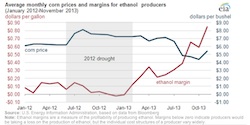 Iowa-based Renewable Energy Group (REG) is planning on buying the assets of Oklahoma’s Syntroleum Corporation. REG announced it had agreed to acquire all of Syntroleum’s assets, including the company’s pioneering Fischer-Tropsch gas-to-liquids and renewable diesel fuel technologies and the company’s 50 percent share in Dynamic Fuels’ 75-million gallon renewable diesel production facility in Geismar, Louisiana. The deal is worth nearly 3.8 million shares of REG common stock (subject to reduction in the event that the aggregate market value of the REG common stock to be issued would exceed $49 million or if the cash transferred to REG is less than $3.2 million).
Iowa-based Renewable Energy Group (REG) is planning on buying the assets of Oklahoma’s Syntroleum Corporation. REG announced it had agreed to acquire all of Syntroleum’s assets, including the company’s pioneering Fischer-Tropsch gas-to-liquids and renewable diesel fuel technologies and the company’s 50 percent share in Dynamic Fuels’ 75-million gallon renewable diesel production facility in Geismar, Louisiana. The deal is worth nearly 3.8 million shares of REG common stock (subject to reduction in the event that the aggregate market value of the REG common stock to be issued would exceed $49 million or if the cash transferred to REG is less than $3.2 million).
“Combining Syntroleum’s renewable and synthetic fuel technologies with REG’s expertise in biodiesel production, sales, marketing and logistics should be a positive outcome for investors in both companies,” said Renewable Energy Group, Inc. President and Chief Executive Officer Daniel J. Oh. “This will help us grow our advanced biofuel business, enhance our intellectual property portfolio, expand our geographic footprint and launch REG into new customer segments.”
“Today’s announcement marks the culmination of our comprehensive process to review Syntroleum’s strategic alternatives to enhance shareholder value,” said Syntroleum President and CEO, Gary Roth. “We are extremely pleased to have found a great partner in REG and to provide our stockholders with the opportunity to participate in a company with significant upside potential. We are confident that REG’s multi-feedstock business model and the combination of our strong management teams will drive increased value for Syntroleum’s stockholders and is the best path forward for Syntroleum.”
Syntroleum has been rumored to be on the sales block since this summer. With the buy, REG, already the Nation’s biggest biodiesel producer, expands its reach beyond its eight active biodiesel refineries in four states with a combined nameplate production capacity of 257 million gallons.











